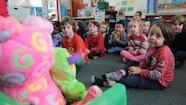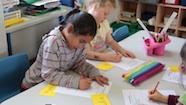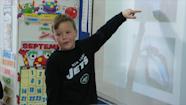Dean Gordon shares how visits within the local community created understanding of the made and natural worlds.
Technology flight inquiry: EOTC in our community
Transcript
Dean Gordon: We’re doing a flight unit and we really wanted to think of a way we could help the kids into it, and we thought what better than to call upon our local flight things that we have around us which is the Otago rescue helicopter is based a kilometre down the road so we thought, well we have to take the kids there. And then the International Airport is 10 kilometres down the road so we thought, well that’s definitely another avenue. I guess the focus on that was kids are seeing flight every day, like we see the rescue helicopter every day, you see Air New Zealand planes every day and they just look at them and don’t really know why they’re there or how they’re up in the sky. So we thought well, yeah, let’s actually call upon these resources and go down and see them which created the excitement for the unit from the get-go and obviously with the small community, several kids had a father, or a mother, or someone who worked in the institutions or has been in the rescue helicopter or anything so it just made it real for them.
So after the helicopters, we went to the Aero Club, the Taieri Aero Club which was fantastic. It was four men who are passionate about flying and they got planes up straight away as we arrived so the children could actually see how the plane lifted off and how it needed to get up its speed along the runway and then once it reached a certain speed, it would take off because it had enough air flowing through and under the wings to get it lifted. They then looped around three times and come into land and talked about what was happening to the wings as they were coming into land and how they, you know, slowed down so that they could create more resistance and things like that and just for the kids to see it was sensational really.
Murray Barrington: We were happy to have the Silverstream Primary School through here a few weeks ago. They were aware of us mostly with an aerobatic pilot who was flying over the airfield and doing some practicing. It’s good that they can get over here and see what’s here really. We’re certainly happy to have the kids over. I understand that they’ve also been to Heli Otago and I’m not sure if they’ve got to the local engineering shop but really great for them to be able to get an understanding of what’s out there in the world, otherwise it’s quite different to just watching an aeroplane fly overhead.
Dean Gordon: And then the museum sleepover which is something we do every two years, we linked that into flight with a bird focus. Sort of moving away from how engines create flight and lift and thrust, and then looking at how birds can create it without an engine through the way their wingspan works and their bone structures and the lightness of their bones and all of those things, because there was quite a cool concept that came up between a lot of my kids saying, well how can birds fly because they don’t have engines? So when we looked closely at the birds, it was really good for the children to see the made world and all of the engines and things that have been created, and then see the natural world and how the made world has been based upon the natural world in the same concepts which really broadened the nature of technology. After those visits we thought, well how can we do tech practice? And we came up with circle gliders, making kites, paper planes, and parachutes. We looked at what was going to be required, what was going to be needed, and the tech process that was going to be needed to get the desirable outcome and to actually make something that was going to fly and create lift.
Andrea Robertson: I guess, having just gone through this process ourselves, my challenge to my colleagues and other teachers out there, is to have a look in your own community. We had thought we’d go into the Otago museum but then when we looked closer, we had a local helicopter club that we could go to, a local airstrip, and then a local airport so you would just be amazed at what you’ve got in your own community that you can utilise.
Related videos
New entrants identify the made world (03:14)
New entrants explore what technology is with teacher Jill Harper.
Year 1–2 technologists design for a purpose (03:52)
Students in years 1 and 2 discuss with their teacher why technologists make things out of different materials.
Year 1–2 future technologists (02:06)
Kathy Chandler and her year 1–2 students discuss technological outcomes and what technologists do.
Cars are technological outcomes (03:53)
James Mawson explores cars as technological outcomes with his year 2 class.




